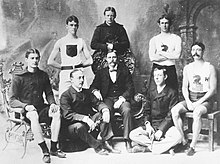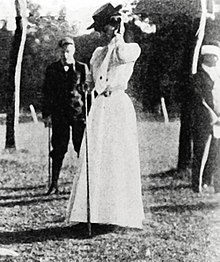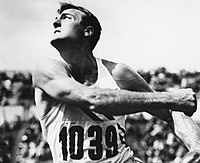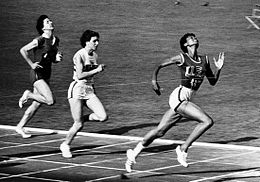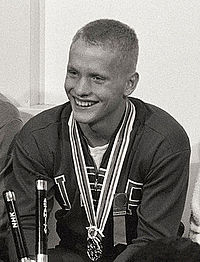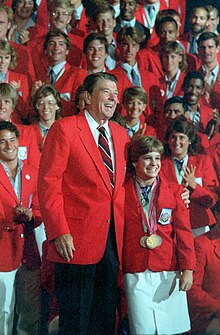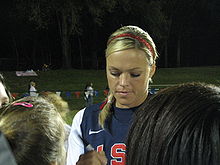United States at the Summer Olympics
When golf returned in 2016, the United States had four men and three women compete in their respective individual events, with Matt Kuchar earning bronze.
Competing as a national team in 1920 and 1924, the Americans had an overall record of 4–2: losing a semifinal match in 1920 before winning the bronze medal game, then going 3–1 in the round-robin in 1924.
James Connolly became the first modern Olympic champion by winning the triple jump, and Thomas Burke won three gold medals in various track events, assuming the title of the most successful athlete of the 1896 Games.
[7] Robert Garrett won two gold medals in the discus throw and shot put events, demonstrating American strength in athletics.
At the 1900 Paris Olympics, the U.S. team featured 75 athletes, a significant increase compared to 1896, but still considerably less than the French hosts, who fielded 720 competitors.
Controversy surrounding the supposed amateurism of athletes led to Thorpe's medals being rescinded due to his involvement in semi-professional baseball.
Several notable American athletes participated in the 1920 Antwerp Olympics, including future legendary figures like swimmer Duke Kahanamoku.
Johnny Weissmuller, who later gained fame as an actor playing Tarzan, secured two gold medals in swimming at the 1928 Amsterdam Olympics.
Throughout these years, track and field remained a cornerstone of Team USA's success, highlighted by standout performances such as Babe Didrikson's achievements.
American swimmers continued their tradition of excellence, with Helene Madison winning three gold medals in the women's freestyle events (100m, 400m, and 4x100m relay).
Lastly, the 1932 Olympics were significant as they were held during the Great Depression, and the success of American athletes provided a morale boost to the nation.
The games also highlighted Los Angeles as a major international city capable of hosting large-scale sporting events.
Moreover, the United States led both gold and overall medal counts at these four Games, establishing itself as a premier sporting power in the world.
Overall, the United States delegations were highly successful during the interwar period, placing first at four consecutive Summer Olympics in 1920–1932 and second in 1936.
The 1948 London Olympics marked the first time that newly communist countries, occupied by the Soviet Union after WW2, competed in the games.
There were calls for the expulsion of the Soviet Union following their invasion of Hungary, but the International Olympic Committee decided not to pursue any action.
The Soviets, continued to dominate Olympic weightlifting, and, with the American program falling short, the USSR produced four golds and three silvers.
In water polo, the Americans struck bronze, tying the eventual gold medalists, the Soviet Union, in the final round.
This was an Olympics of contrasts: the U.S. men's swimming team, despite the generally dismal showing of the overall delegation, swept 12 gold and 27 total medals in the 13 events that were on the program and broke 11 world records in the process,[28] while the US women's swimming team, on the other hand, fell victim to what was later shown to be a pervasive East German doping program.
The event was held on the last day of the swimming program, and the American women were risking being deprived of gold for the first time in U.S. Olympic history.
The victory was somewhat overlooked at the time, but since the early 1990s, when public revelation of the doping program began, the American gold medal is considered to be one of the sport's most improbable upsets.
The achievement was even more notable due to the fact that the American boxers were significantly younger and less experienced than their Cuban and Soviet counterparts.
However, no threat to Eastern Bloc athletes was ever discovered, and the athletes from the Eastern Bloc country that did attend the 1984 games in Los Angeles—Romania—encountered no problems, and in fact were widely cheered above all other visiting nations at the Opening Ceremonies when they marched into the Los Angeles Memorial Coliseum (Romania ended up finishing second in the medal table at the Games).
[39] The 1984 Los Angeles Summer Olympics marked the first time that the Games were broadcast in multiple channels simultaneously, offering viewers a variety of events to watch.
With a silver in the women's team final and bronze in the individual uneven bars Lee left Tokyo with an impressive three Olympic medals.
Recent major champion Nelly Korda followed the winning ways of compatriot Xander Schauffele to take home gold in the women's golf competition.
[47] There were rumors that the Communist party had bribed the officials because they wanted the USSR to win 50 gold medals at these Olympics in commemoration of the 50th anniversary of the Soviet Union.
Although the unexpected sound of the horn caused lead referee Renato Righetto to turn away from the free throw attempt and look over to the scorer's table, play was not stopped.
The Americans regained the basketball crown in 1976, but their ability to stay competitive with college players against seasoned professionals from the Soviet Union was decreasing.
[49][50][51] Since the beginning of the 21st century, China with its booming economy has replaced Russia as the United States' main rival in terms of the Summer Olympics medal count.
